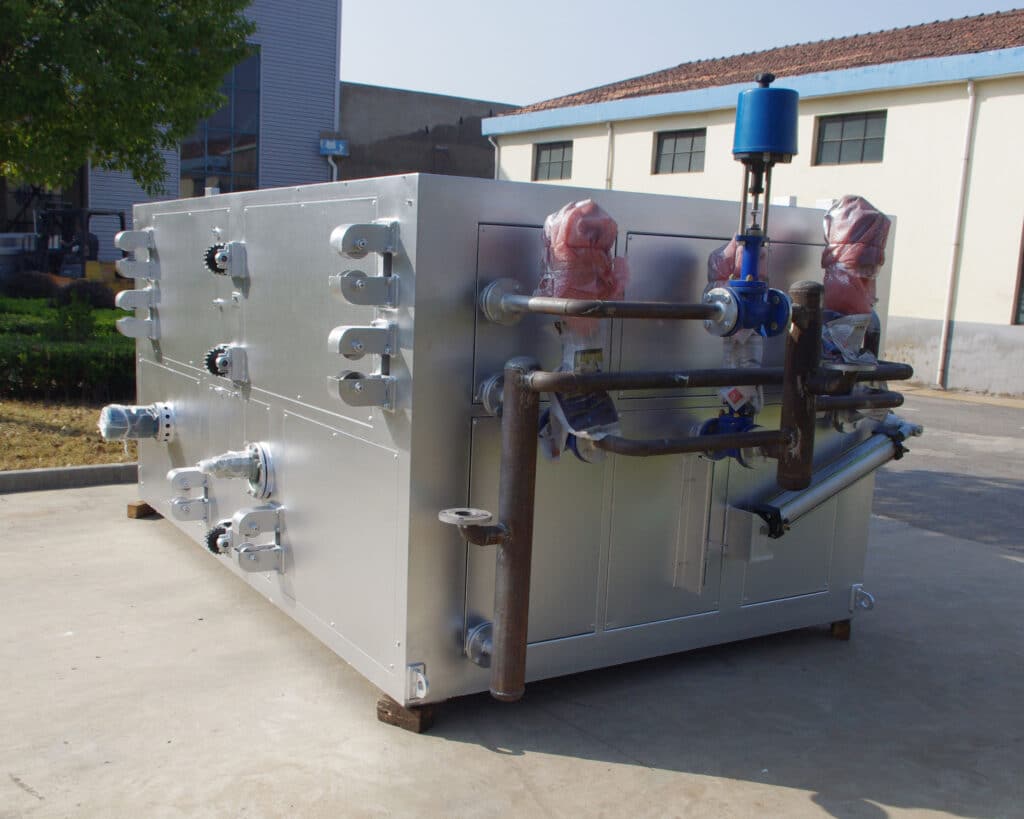Industrial ovens are commonly used heating equipment in modern manufacturing and production processes, and are widely used in electronics, pharmaceutical, food, automotive and other industries. Different types of ovens are suitable for a variety of heating, drying, baking and other operating environments. Choose the right oven can greatly improve production efficiency and reduce energy consumption. Jiangsu Ruiyuan Heating Equipment Technology Co., Ltd. focuses on the design and manufacture of industrial heating equipment, to provide you with comprehensive oven solutions.
1. Common oven types
1.1 Hot air circulation ovens Hot air circulation oven is one of the most widely used types, using a fan to circulate hot air inside the box, thus making the temperature inside the oven more uniform. It is suitable for materials that need to be heated evenly, such as pharmaceuticals, chemical raw materials, electronic products and so on. Hot air circulation ovens usually have high temperature stability and are suitable for processes that require high temperature control.
1.2 Vacuum ovens Vacuum ovens are mainly used to treat substances that are prone to oxidisation or decomposition. The internal vacuum effectively reduces the oxygen content of the air, thereby reducing the risk of oxidisation of materials. The ovens are commonly used for drying and heat treating electronic devices, chemical reagents, and pharmaceutical materials, and are widely used in precision manufacturing and laboratory environments.
1.3 Blast drying ovens Blast drying ovens are usually used for rapid drying of various materials. Their fast heating rate and good ventilation make them suitable for rapid heating or drying in laboratories and small batch production. The relatively simple structure of this type of oven makes it suitable for heating applications that do not require high temperature uniformity.
1.4 Infrared ovens Infrared oven sends out infrared rays through infrared heating element to heat the object directly, which can reach the required temperature in a short time, and it is suitable for the items that react faster to the temperature, such as the curing of paints, glues and other materials. Infrared oven is suitable for rapid drying and heating, commonly used in printing, packaging and other industries that require short time drying.
1.5 High temperature oven High-temperature ovens are suitable for special materials that require high-temperature heating, and their upper temperature limit can reach 300°C or even higher, and are widely used in processes such as annealing and heating of ceramics and metal parts. High-temperature ovens have excellent thermal insulation and can withstand higher temperatures, so they are suitable for metal processing and high-temperature treatment industries.
2. Main functions of various ovens
2.1 Heating and drying The basic function of almost all ovens is heating and drying, which is used to evaporate water or other liquids from materials. For example, both hot air circulation ovens and vacuum ovens are effective for drying operations, but vacuum ovens provide more thorough drying and are suitable for products with high moisture content.
2.2 Sterilisation and disinfection In the pharmaceutical and food industries, ovens are commonly used for sterilisation and sterilisation processes. Vacuum ovens can also sterilise at low temperatures and are ideal for drying and sterilising pharmaceutical raw materials, while high temperature ovens can be used for sterilising metal equipment and high temperature resistant materials.
2.3 Curing and heat treatment In the treatment of materials that require curing, such as paints and adhesives, infrared ovens are heated to achieve a fast and uniform curing effect. And high-temperature ovens are commonly used in the heat treatment of metals, ceramics and other materials to make the internal structure of the material more stable through slow heating at high temperatures.
2.4 Temperature control precision Blast drying ovens and vacuum ovens are equipped with advanced temperature control systems, capable of precise control in different temperature ranges to meet the heating needs of temperature-sensitive materials. Temperature control accuracy is an important indicator affecting the performance of the oven, especially important in the production of electronic components and high-precision instruments.
3. How to choose the right industrial oven
Selected according to industry needs: In the production of electronic components, vacuum ovens can reduce the risk of oxidation; in the chemical industry, hot air circulation ovens are suitable for drying powder or granular materials. When choosing an oven, judgement should be made according to the characteristics of the material, the need for temperature control and the production environment.
Selection according to temperature requirementsFor general drying and low-temperature processing, a hot-air circulation oven is sufficient; for materials with high-temperature requirements, a high-temperature oven can be selected. For processes that require high temperature uniformity and accuracy, a blast drying oven or vacuum oven can be selected.
Jiangsu Ruiyuan Heating Equipment Technology Co., Ltd. provides a wide range of industrial oven types and tailor-made services to meet the special heating needs of various industries. We have a professional technical team that can recommend the most suitable oven equipment according to your specific needs.
Our company can non-standard custom products, click the menu bar to contact us to customise, you can also refer to the first!product pageAppreciate our company's products oh!
Recommended Reading:
